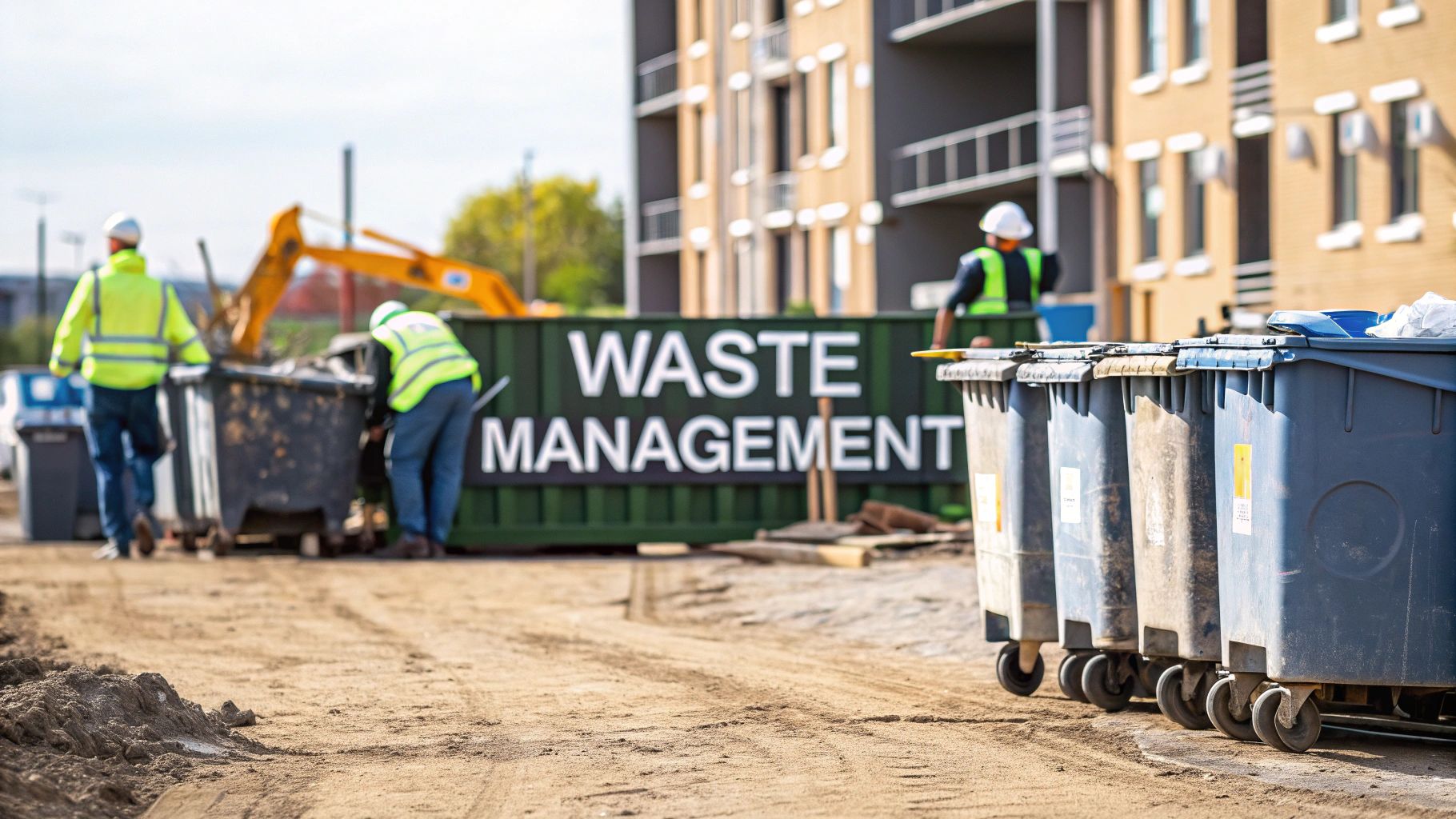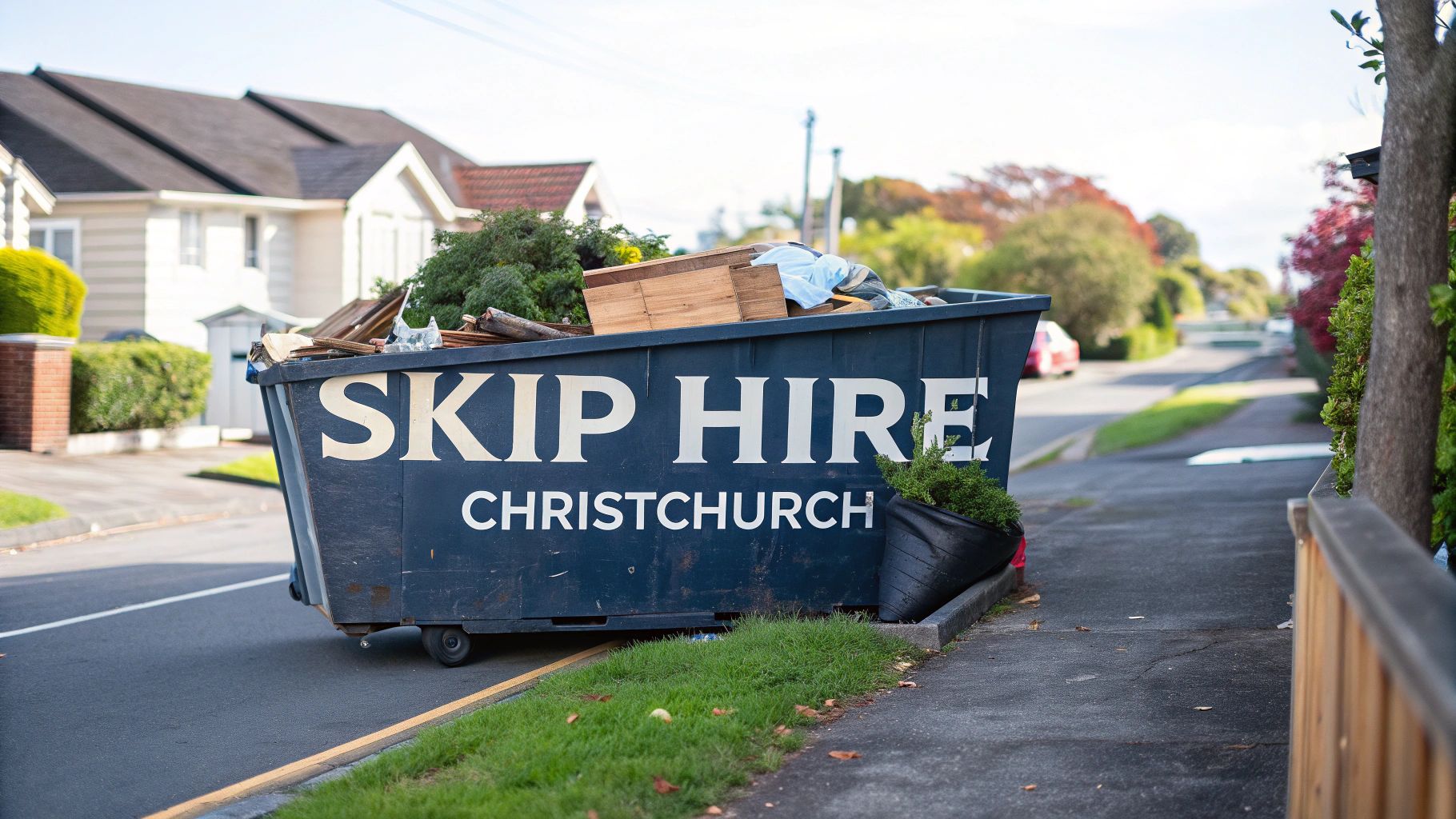UK Hazardous Waste Disposal Regulations Guide | The Waste Group
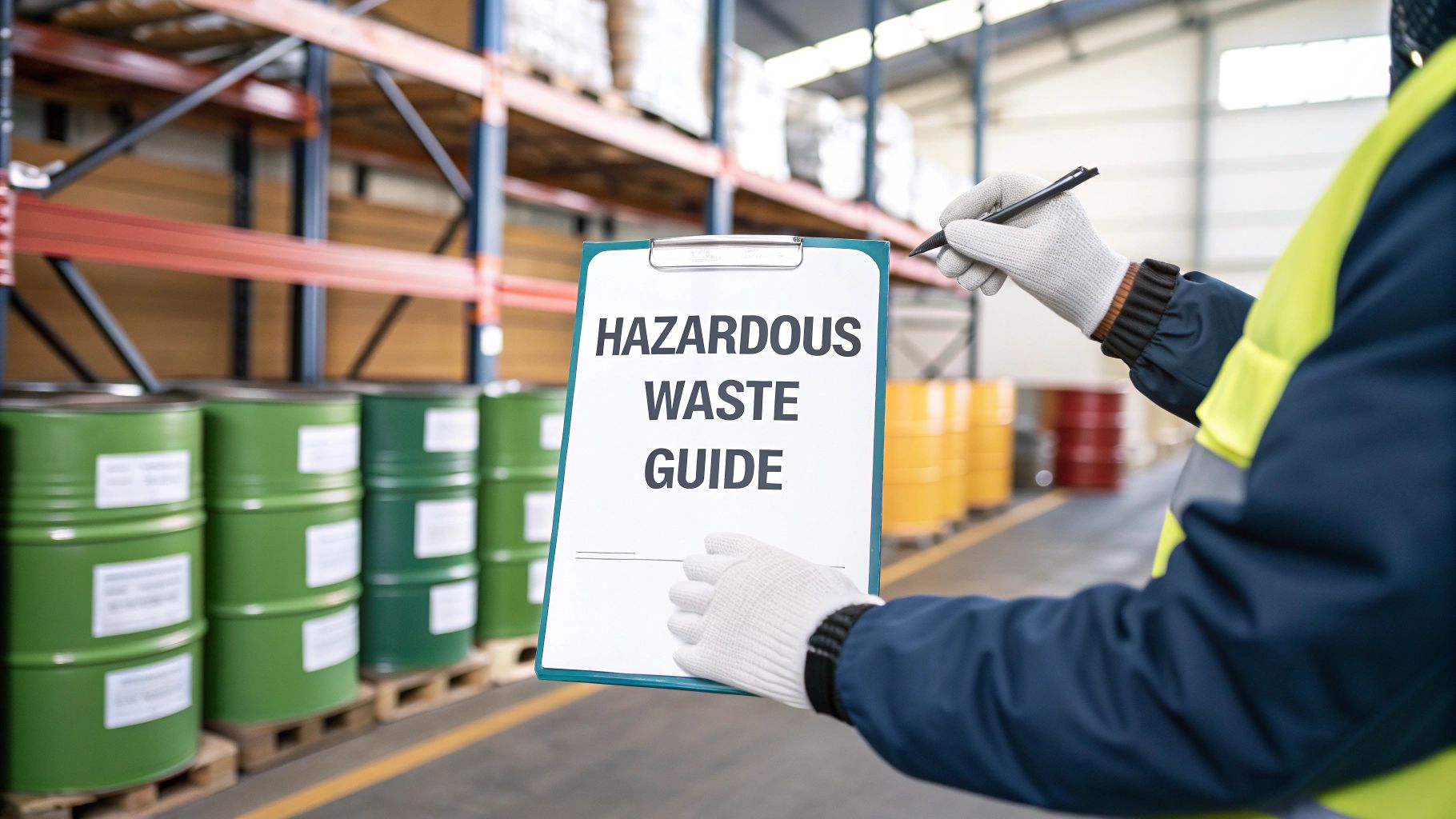
UK Hazardous Waste Disposal Regulations Guide
When it comes to hazardous waste, there’s one core legal principle that underpins everything: the ‘duty of care’. Put simply, it’s your legal responsibility to make sure any hazardous waste you produce is managed safely and correctly, from the moment it’s created right through to its final disposal. It’s all about protecting people and the environment.
Understanding Your Legal Duties For Hazardous Waste
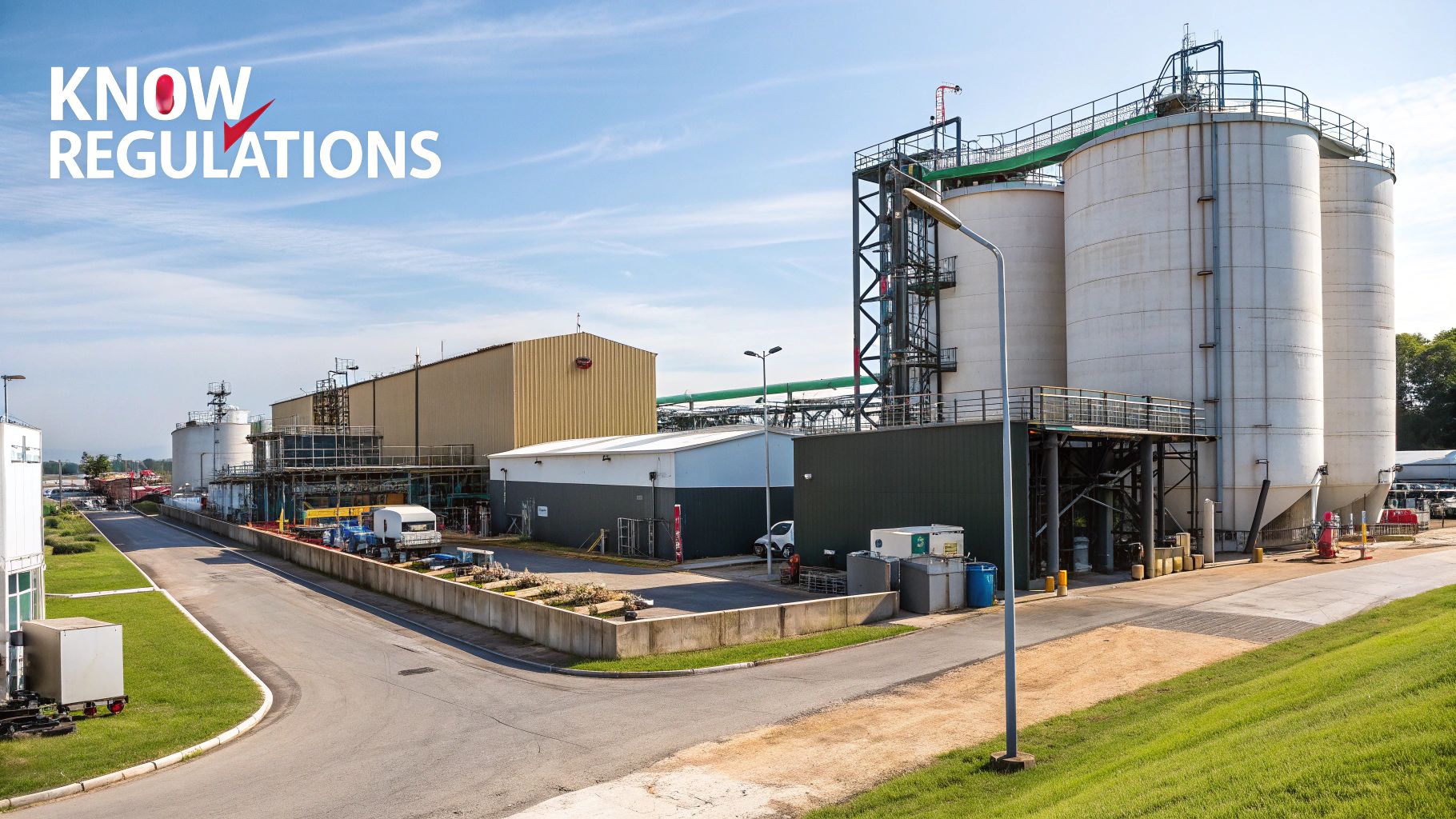
Wading through hazardous waste rules can feel daunting, but the ‘duty of care’ gives you a clear mission. Think of it like an unbroken chain of responsibility. As the person or business that created the waste, you’re the first link in that chain. You’re responsible for what happens to it, even long after it’s left your premises. This duty only ends once the waste is properly and legally recovered or disposed of.
Getting this wrong isn’t just a slap on the wrist. Failing to meet your duty of care can land you in serious legal and financial trouble. The Environment Agency in England (and its counterparts across the UK) takes enforcement very seriously, all to prevent pollution and keep the public safe. They hold businesses firmly accountable for the waste they produce.
Core Principles Of Your Duty Of Care
At its heart, your duty of care breaks down into a few key actions you absolutely must take to stay on the right side of the law. These principles are the foundation of all hazardous waste regulations and give you a solid framework to follow.
- Prevent Unauthorised Handling: You must take all reasonable steps to stop anyone from messing with your waste illegally. That means keeping it secure on your property so it can’t be fly-tipped or handled by the wrong people.
- Contain Waste Securely: It’s vital to make sure your waste doesn’t escape. This means using the right kind of containers—ones that are sealed, suitable for the waste type, and clearly labelled to prevent any leaks or spills.
- Transfer To An Authorised Person: You can only hand over your hazardous waste to someone who is legally allowed to take it, like a licensed waste carrier or a permitted disposal site. Always, always check their credentials.
- Provide An Accurate Description: When the waste is collected, you must fill out the right paperwork (like a hazardous waste consignment note) with a full and honest description of what’s inside. No guesswork allowed.
A huge part of your legal duty involves getting the labelling right. Sticking to regulatory compliance in labelling is non-negotiable, as it ensures everyone down the line knows exactly what they’re dealing with and what the risks are.
Why This Matters For Your Business
Fulfilling your duty of care is about more than just dodging fines; it’s a cornerstone of being a responsible business. When you manage your waste correctly, you’re protecting your staff from harmful substances, safeguarding your company’s reputation, and doing your bit for the local environment. It turns a legal headache into a smart risk management strategy.
For a more detailed breakdown, our guide covers the key steps to safely manage hazardous waste in the UK. Getting a grip on these principles is the first step toward creating a waste management plan that’s both effective and completely compliant.
How to Classify Hazardous Waste Correctly
Before you can even think about managing hazardous waste, you first need to know exactly what you’re dealing with. Getting your waste classification right isn’t just some box-ticking exercise; it’s the absolute foundation of your duty of care. It’s what keeps everyone safe, from your own team to the specialists at the final disposal facility.
Think of it like a doctor needing to diagnose an illness before they can prescribe the right treatment. One wrong move at the start can cause a world of trouble later on. You need to look past the item itself and pinpoint the specific properties that make it dangerous. Is it flammable? Is it toxic? Corrosive? A threat to the environment? Answering these questions is the first step in getting hazardous waste disposal regulations right.
Understanding Hazardous Properties
The law is pretty clear on what makes waste hazardous, and it all comes down to a list of specific properties. If your waste has one or more of these traits, it has to be managed under strict rules. You don’t need a chemistry degree, but you do need a practical understanding of what these terms mean for your business.
A few of the key hazardous properties include:
- Flammable: This is anything that can easily catch fire. We’re talking about things like solvents, some paints, and various oils.
- Toxic: These are substances that are poisonous if they get into the body – whether that’s through breathing, swallowing, or skin contact. Think pesticides or heavy metals.
- Corrosive: This is waste that can literally destroy other materials it touches, including human skin. Strong acids or alkalis in industrial cleaning products are a common example.
- Ecotoxic: These are materials that could cause serious harm to the environment if they escaped, especially to rivers and aquatic life.
Getting a handle on these properties is absolutely vital because it determines everything that comes next. It dictates how you store the waste, what kind of container you need, how it must be labelled, and which specialist facilities are even allowed to take it off your hands.
This chart shows how the different authorities responsible for these rules fit together.
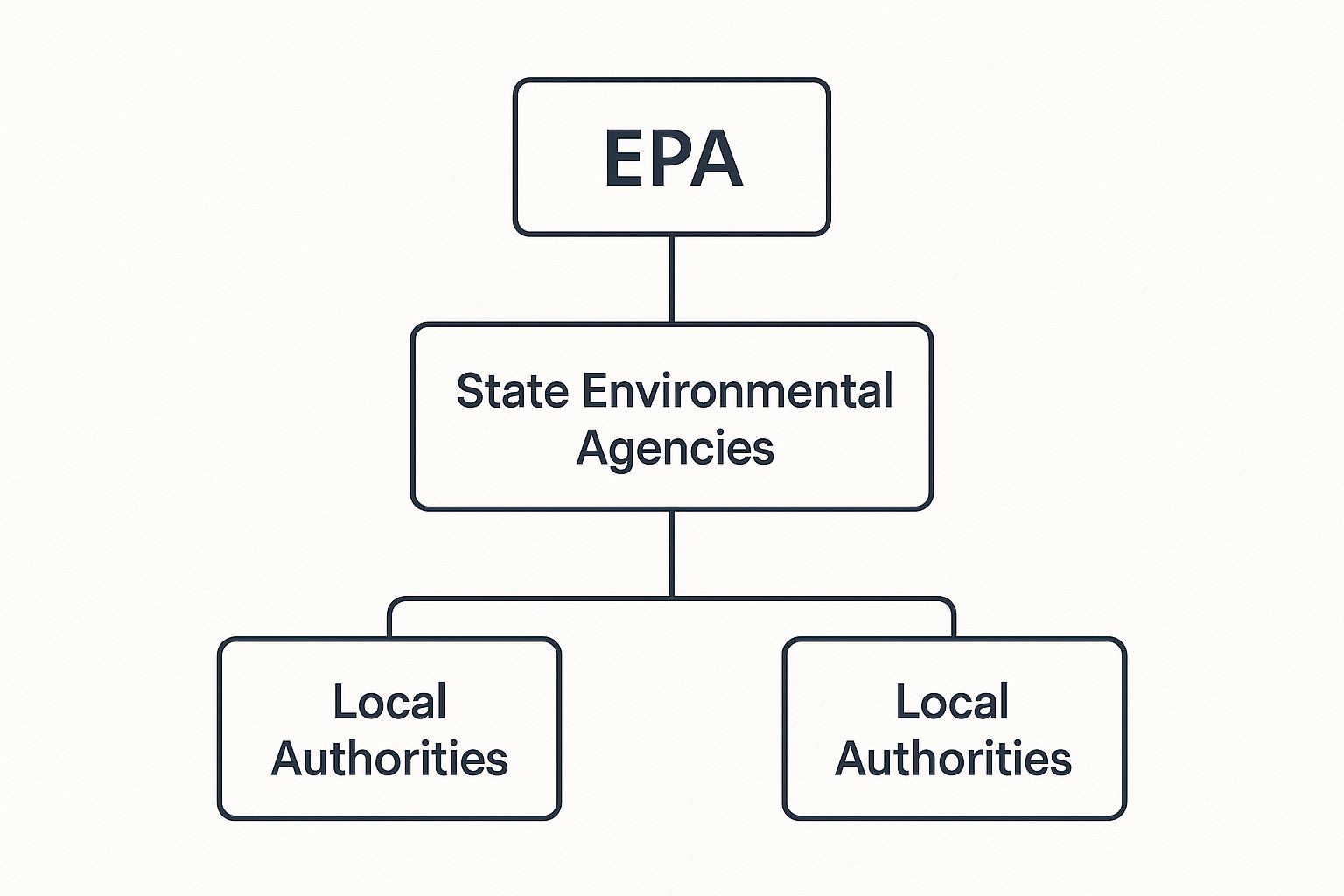
As you can see, national bodies create the overarching framework, while regional and local agencies handle the enforcement and adapt the rules to fit specific local needs.
Decoding European Waste Catalogue Codes
Once you’ve identified a waste stream as being potentially hazardous, the next job is to assign it a specific code from the European Waste Catalogue (EWC). You might also hear this called the List of Wastes.
Think of the EWC as a massive, detailed library system for every type of waste imaginable. Each one gets a unique six-digit code that tells everyone exactly what it is and where it came from. The system is organised into chapters based on the industry or process that created the waste. For instance, all waste from construction and demolition sits in Chapter 17, while waste from chemical processes is found in Chapter 07.
These codes are non-negotiable for the consignment note – the legal paperwork that tracks the waste from the moment it leaves your site. Using the right EWC code ensures total transparency and gives hauliers and disposal sites the critical information they need to handle it safely.
To help businesses get a better idea of what to look for, here’s a quick-reference table showing some common hazardous wastes found in different sectors across the UK.
Common Hazardous Waste by Industry Sector
| Industry Sector | Common Hazardous Waste Examples | Typical EWC Code (Example) |
|---|---|---|
| Automotive/Garages | Used engine oil, brake fluids, antifreeze, oily rags, old batteries | 13 02 08* (other engine, gear and lubricating oils) |
| Construction | Asbestos-containing materials, solvent-based paints, adhesives, sealants | 17 06 05* (construction materials containing asbestos) |
| Healthcare/Dental | Sharps, contaminated dressings, certain pharmaceuticals, amalgam waste | 18 01 03* (wastes whose collection and disposal is subject to special requirements) |
| Manufacturing | Solvents, acids, alkalis, heavy metal sludges, contaminated packaging | 06 01 01* (sulphuric acid and sulphurous acid) |
| Printing | Inks, developing solutions, cleaning solvents, contaminated cloths | 08 03 12* (waste ink containing hazardous substances) |
| Dry Cleaning | Perchloroethylene (PERC) and other solvents, contaminated filters | 12 01 14* (machining sludges containing hazardous substances) |
Remember, this isn’t an exhaustive list, but it should give you a starting point for identifying potential hazardous waste streams within your own operations. Always refer to the official List of Wastes for precise classification.
Conducting a Waste Stream Audit
By far the most practical way to classify your waste properly is to carry out a waste stream audit. This just means taking a methodical walk through your business to see what you’re throwing away and identify anything that could be hazardous.
- Walk Your Operations: Start where raw materials come in the door and follow their journey right through to the point they become waste in your bins.
- Check Product Information: Get hold of the Safety Data Sheets (SDS) for any chemicals you use, and check the manufacturer’s guidance for things like electronics or batteries. These documents will usually tell you if an item becomes hazardous waste.
- Segregate at the Source: As soon as you identify something hazardous, get it separated from your general waste. This is so important for preventing cross-contamination, which is not only dangerous but can be incredibly expensive to sort out.
- Document Everything: Keep a clear, simple record of the types of hazardous waste you generate, how much there is, and the EWC codes you’ve assigned. This paperwork is your proof that you’re doing things by the book.
By taking a systematic approach to classifying your waste, you build a solid foundation for a safe and compliant management system. It’s the best way to protect your business from the very serious risks of getting it wrong.
Getting to Grips with UK Waste Legislation
To handle hazardous waste correctly, you first need to understand the laws that govern it. In the UK, the rules aren’t just a single piece of legislation; they’re a web of interconnected regulations designed to protect both people and the planet. Getting this right isn’t optional—it’s a non-negotiable part of doing business.
The main player for businesses in England and Wales is The Hazardous Waste Regulations. Think of this as the core rulebook. It lays out exactly what counts as hazardous waste, who is legally allowed to handle it, and the crucial paperwork needed to track its journey from start to finish.
This legislation is what puts the legal weight behind the ‘cradle-to-grave’ principle. It formalises your duty of care and creates an unbroken chain of responsibility. Every single business that produces, moves, or gets rid of hazardous materials is a link in that chain, with its own set of legal duties to uphold.
COSHH: The Cornerstone of Workplace Safety
Another critical piece of the puzzle is the Control of Substances Hazardous to Health Regulations, or COSHH as it’s better known. Many people think of COSHH purely as a workplace safety law for protecting staff from dangerous chemicals, but its reach extends directly into waste management. At its heart, COSHH is all about managing risk.
It requires every employer to assess the risks posed by hazardous substances and then take practical steps to prevent or control exposure. This duty doesn’t just stop once a chemical has been used; it follows that substance all the way through to its disposal. It’s simple, really: if a substance is a danger to your team, its waste is almost certainly a danger to the environment.
This makes your COSHH assessment an incredibly useful tool for spotting hazardous waste streams right at the source. It shifts waste management from being an afterthought to being a proactive part of your health and safety culture, protecting your people, the environment, and your business’s legal standing.
The UK’s approach to hazardous waste has evolved significantly. A major landmark was the introduction of the Control of Substances Hazardous to Health Regulations (COSHH) in 1988, which came into force on 1st October 1989. This legislation replaced many older, industry-specific laws and created a systematic framework for controlling exposure to hazardous substances, directly shaping how hazardous waste is managed in occupational settings. You can explore more about this pivotal legislation’s background and its impact on UK safety standards.
How These Rules Work Together
It’s much easier if you see these regulations not as separate hurdles, but as overlapping layers of protection. Each one has a specific job, but they all work together to make sure hazardous materials are managed safely from the moment they arrive to the moment they’re disposed of.
Here’s a practical look at how they connect:
- COSHH Identifies the Risk: It all starts here. You use COSHH guidelines to assess the chemicals and materials you use at work. This is the step that flags which substances will end up as hazardous waste.
- The Hazardous Waste Regulations Dictate the Process: As soon as waste is identified as hazardous, it falls under the strict control of The Hazardous Waste Regulations. This law tells you exactly how to separate it, store it, and label it correctly.
- The Duty of Care Underpins Everything: Your general duty of care, set out in the Environmental Protection Act, is the legal obligation that makes sure you follow the rules. It’s what compels you to hire a licensed waste carrier and fill out all the proper paperwork.
This joined-up system is designed to leave no gaps. From a hazardous substance entering your site to its waste being safely treated, there is a clear legal path to follow.
The ‘Cradle-to-Grave’ Responsibility
The idea of ‘cradle-to-grave’ is absolutely central to UK hazardous waste law. It means that you, as the business that created the waste, are legally responsible for it throughout its entire life—from the moment it’s made (the cradle) right up to its final disposal or recovery (the grave).
This unbreakable chain of responsibility is enforced through paperwork, most importantly the Hazardous Waste Consignment Note. This legal document is like a passport for your waste. It tracks the entire journey and ensures every company involved signs off on its safe transfer.
Your legal responsibility only officially ends when you get confirmation from the final disposal facility that your waste has been processed correctly. This is why choosing a reputable and fully licensed waste management partner is so vital. They are the last critical link in your compliance chain, and any failure on their part is a failure on yours. If that final step isn’t completed and documented properly, you haven’t fulfilled your duty of care.
Your Guide to Safe On-Site Handling and Storage
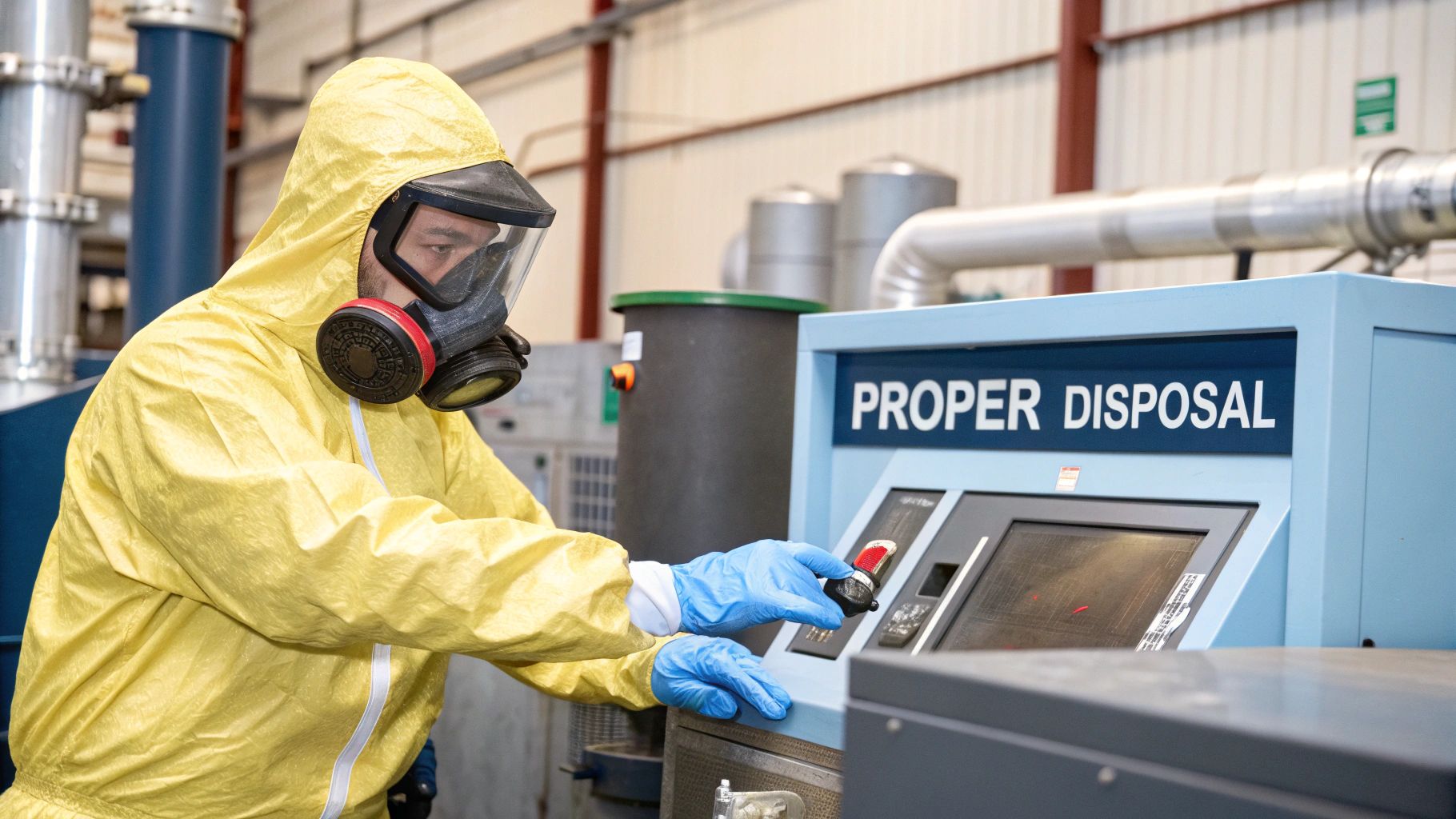
Staying compliant with hazardous waste rules starts long before a collection lorry shows up at your door. In fact, how you handle and store these materials on your own property is the first, and most important, step in your duty of care. Get this bit right, and you’re setting the whole process up for success.
Think of it like a professional kitchen. A good chef knows you can’t store raw chicken next to fresh salad—it’s just asking for trouble. The exact same logic applies to hazardous waste. Safe storage isn’t just about being tidy; it’s a legal must-have to prevent dangerous chemical reactions, keep your staff safe, and stop pollution in its tracks.
Selecting the Right Containers
First things first: you have to use the right container for the job. You can’t just chuck hazardous waste into any old bin liner or drum you have lying around. The regulations are crystal clear that containers must be fit for purpose. This means they need to be tough enough to hold the waste without leaking and made from a material that won’t have a bad reaction with whatever’s inside.
For many types of hazardous materials, this points to UN-approved packaging. These aren’t just any containers; they’ve been put through the wringer with rigorous testing to meet strict standards for transporting dangerous goods. Using them gives you peace of mind that your waste is securely locked away from the moment you seal it.
Key Takeaway: Your container is the first line of defence. It has one job: to keep the waste from escaping. Always double-check that your container is suitable for the specific material you’re storing to avoid nasty surprises like corrosion, leaks, or even a dangerous build-up of pressure.
The Importance of Clear and Compliant Labelling
A container without a label is a recipe for disaster. Every single container holding hazardous waste must be clearly and accurately labelled with its contents. This isn’t just good practice—it’s a non-negotiable part of the law.
Your labels need to include:
- The name of the substance: Be specific about what’s inside.
- The correct EWC code: This is its official legal classification.
- The nature of the hazard: Use the proper hazard pictograms (like the flame symbol for flammable liquids).
- The producer’s details: That’s your company name and address.
Good labelling is all about communication. It tells everyone who comes into contact with that container—from your team to your waste carrier—exactly what the risks are so they can handle it safely.
Segregation and Secure Storage Areas
You can’t just pile all your hazardous waste together and hope for the best. Remember those chemistry lessons at school? Mixing the wrong chemicals can cause fires, release toxic fumes, or even trigger explosions. That’s why segregation is mandatory. Incompatible wastes, like acids and alkalis, absolutely must be kept well apart.
On top of that, the area where you store it has to meet certain standards. It should be:
- Secure: Kept locked up tight to stop anyone who shouldn’t be there from getting in.
- Impermeable: The surface must be sealed so any spills are contained.
- Weatherproof: A roof is ideal to stop rainwater from getting in, which could cause leaks or reactions.
Part of your planning should also involve choosing the right chemical storage tank for your facility, especially if your business produces larger amounts of liquid hazardous waste.
Things can get particularly tricky on construction sites because the environment is constantly changing. For more tailored advice, check out our guide on managing hazardous waste on construction sites. By making these rules part of your everyday routine, you’re not just staying compliant—you’re creating a safer place to work.
Mastering Consignment Notes and Record Keeping
When it comes to hazardous waste disposal regulations, there’s a golden rule: if it isn’t documented, it didn’t happen. This is where the consignment note steps in. Think of it not as a tedious piece of paperwork, but as your waste’s legal passport.

This single document is your proof that you’ve met your legal duty of care. It creates a solid, unbroken paper trail, tracking your waste from the moment it leaves your site to its final, safe destination. Without it, you’re left completely exposed, with no evidence that you followed the law.
The Consignment Note As Your Legal Passport
A consignment note must be filled out for every single collection of hazardous waste. No exceptions. It’s a multi-part form designed to pass from you (the producer) to the carrier, and finally to the disposal site, with each party signing off and taking legal responsibility.
As the producer, the first part is on you. You’ll need to provide:
- Your Details: The address where the waste came from.
- The Waste Description: A clear description, including the process that created it and the correct European Waste Catalogue (EWC) code.
- Container and Quantity Information: The type of containers, how many there are, and the total weight.
- Your Declaration: Your signature, confirming everything is accurate and you’ve done your part.
The carrier then signs their section when they pick it up, and the final disposal site (the consignee) signs off when they receive and process it. This creates a closed-loop system where every stage is accounted for.
Think of the consignment note as a legal handshake between each link in the chain. Every signature is a formal acceptance of responsibility, ensuring the hazardous material is always in safe, authorised hands and accountability is never lost.
Record Keeping: Your Legal Safety Net
Once the waste is gone, your job isn’t quite finished. UK law is very clear: you must keep copies of all hazardous waste consignment notes for a minimum of three years. This isn’t a friendly suggestion—it’s a strict legal requirement.
These records are your first line of defence if the Environment Agency ever pays you a visit. If an officer asks to see your paperwork and you can’t produce it, that’s an immediate red flag and a breach of the rules. Keeping everything organised and accessible shows you’re a professional who takes compliance seriously.
The rules around transporting dangerous materials are tight for a reason. Ever since 1986, the Health and Safety Executive (HSE) has enforced strict regulations for moving dangerous goods by road, covering everything from secure packaging to proper labelling to prevent accidents. You can explore the history of these critical safety regulations to see how they’ve evolved to protect us all.
This three-year rule ensures that if a problem like illegal dumping is discovered down the line, regulators can trace the waste right back to its source. It reinforces the ‘cradle-to-grave’ principle, holding everyone accountable. Consider your archive of consignment notes your business’s legal safety net.
The Real Costs of Non-Compliance
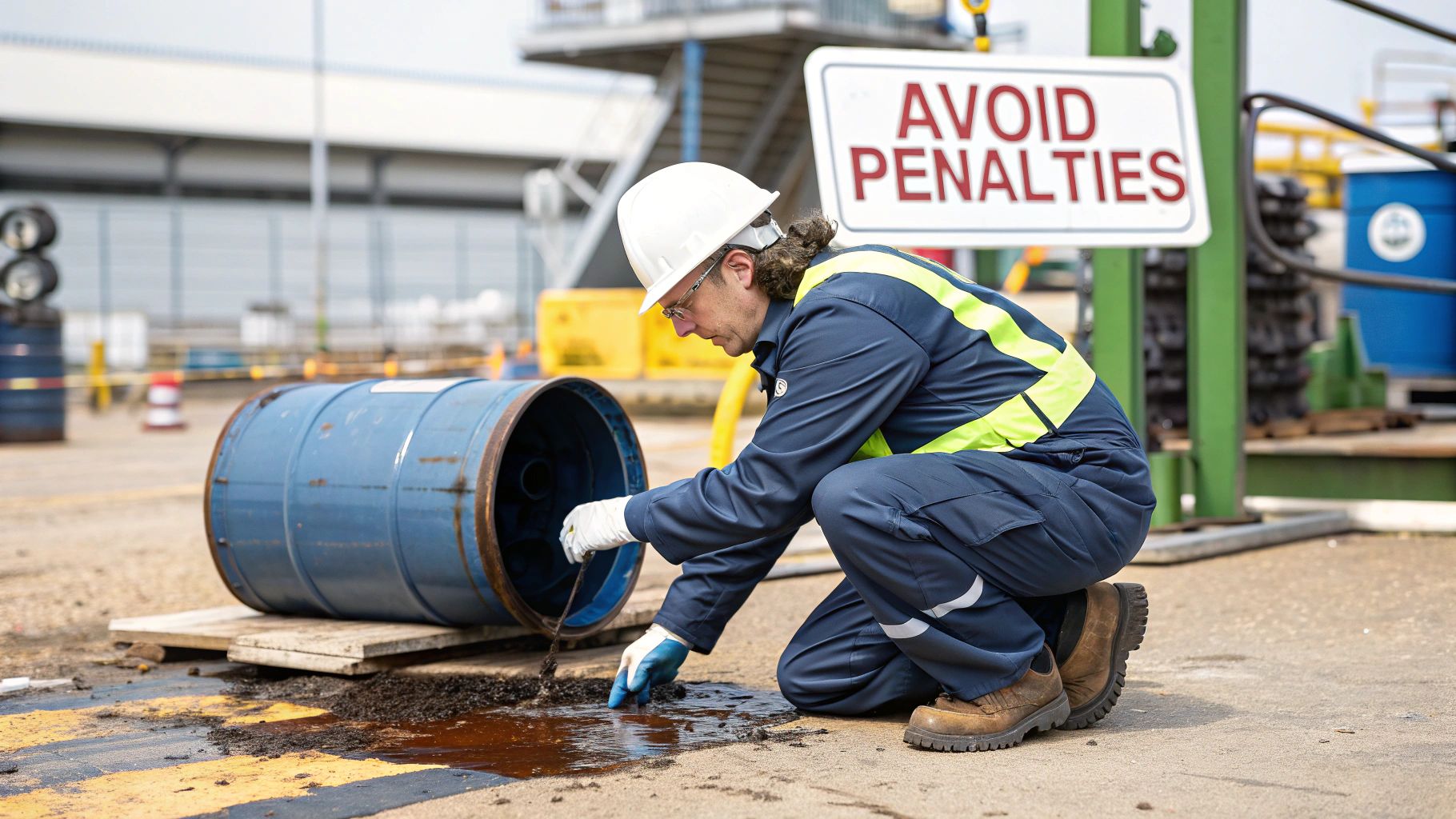
Knowing your legal duties is one thing, but truly understanding the real-world stakes is what brings the importance of hazardous waste disposal regulations into sharp focus. Ignoring the rules isn’t just a minor slip-up; it’s a huge business risk with consequences that go way beyond a simple warning letter.
The penalties are tiered, starting with fixed penalty notices for smaller mistakes like dodgy paperwork. But for more serious offences, the consequences ramp up quickly. The Environment Agency can issue unlimited fines and, in the worst cases, even pursue criminal prosecution, which can lead to prison sentences.
Financial Penalties and Legal Action
The most obvious hit comes from financial penalties, which are designed to be a serious deterrent. A simple oversight, like not securing your waste properly, can land you with a hefty fine that eats directly into your profits.
But the fines are often just the start. If your improperly handled waste causes environmental damage or harms someone’s health, you could be facing enormous clean-up costs handed down by the Environment Agency. These operations are complex, expensive, and you’ll be footing the entire bill.
The trouble doesn’t stop with the regulators, either. You also open your business up to civil lawsuits. If your waste contaminates a neighbour’s property or makes someone ill, you could be staring down the barrel of costly legal battles and compensation claims that could easily cripple your business.
Beyond the Balance Sheet: Hidden Costs
While the financial and legal penalties are severe, some of the most lasting damage isn’t measured in pounds and pence. The hidden costs can be just as devastating for a business in the long run.
- Reputational Damage: News of environmental negligence travels fast. Being known as a polluter can destroy customer trust and brand loyalty that you’ve spent years building.
- Operational Disruption: A major investigation can lead to your site being partially or completely shut down, bringing your operations to a grinding halt and causing massive delays and loss of income.
- Increased Scrutiny: Once you’re on the regulator’s radar for non-compliance, you can bet they’ll be watching you much more closely in the future, adding extra admin and stress.
A big reason for this strict enforcement is the sheer amount of hazardous material being produced. With substantial quantities generated in England and Wales each year, enforcement actions for improper waste handling have jumped by over 20% recently as regulatory bodies tighten their oversight.
Illegal Dumping: The Ultimate Risk
The most serious offence of all is illegal dumping, or fly-tipping as it’s more commonly known. This isn’t seen as a mistake but as a deliberate criminal act, and the penalties reflect that. It frequently leads to court appearances, unlimited fines, and even jail time for the people responsible.
It’s vital to know the difference. You can learn more about illegal dumping vs legal tipping in our guide. At the end of the day, compliance isn’t just an expense—it’s an essential investment in your business’s security, reputation, and long-term survival.
Common Questions on Hazardous Waste Compliance
Getting your head around the regulations is one thing, but applying them to your daily business operations often throws up a few curveballs. Let’s tackle some of the most common questions we hear, giving you clear, straightforward answers to help you stay compliant.
Figuring out these common sticking points is a massive step towards building a solid, legally-sound waste management plan.
Do These Regulations Apply to My Small Business?
In a word, yes. Almost every single business in the UK has a ‘duty of care’ for the waste it produces. If you’re generating anything classed as hazardous – think used fluorescent tubes, certain industrial cleaning chemicals, or even old computer monitors – you have to follow the rules.
There are no get-out clauses based on your company’s size. The law cares about the type of waste you’re creating, not how big your operation is. Your first, most crucial step is to properly identify and classify everything you throw away. If you’re ever in doubt, it’s always smarter to assume an item is hazardous and get some expert advice from a certified waste management partner.
Can I Transport My Own Hazardous Waste?
While it might seem like a simple way to save a bit of money, transporting your own hazardous waste is a regulatory minefield. It’s something we generally advise against for most businesses.
To even consider it, you must be officially registered as a waste carrier with the Environment Agency. On top of that, your vehicle has to meet specific safety standards for carrying dangerous goods, which usually means specialised kit and extra insurance. For nearly all businesses, using a licensed hazardous waste collection service is the safest, most efficient, and legally watertight choice. They have the right permits, trained staff, and proper vehicles to do the job right.
Using a licensed carrier is a vital part of your duty of care. It means that from the moment the waste leaves your premises, it’s in the hands of trained professionals, shielding you from the massive liabilities that come with any transport mishaps.
What Is the Difference Between a WTN and an HWCN?
Getting this right is absolutely critical for your paperwork. A Waste Transfer Note (WTN) is the standard document you need whenever you pass non-hazardous waste to someone else.
A Hazardous Waste Consignment Note (HWCN), on the other hand, is a much more detailed and legally beefed-up document specifically for hazardous materials. The HWCN has extra information that a WTN doesn’t, including things like:
- A unique consignment note code for tracking its journey.
- A detailed chemical or biological breakdown of the waste.
- Sign-offs from the producer (you), the carrier, and the final disposal site.
This extra detail creates a much stricter paper trail, which makes sense given the higher risks involved with hazardous waste. Getting this document right isn’t just a good idea—it’s a non-negotiable part of the regulations.
Navigating these rules can feel complicated, but you don’t have to tackle it alone. For expert advice and fully compliant disposal services, contact The Waste Group to ensure your business stays safe and on the right side of the law. Visit our website to learn more at https://www.thewastegroup.co.uk.
